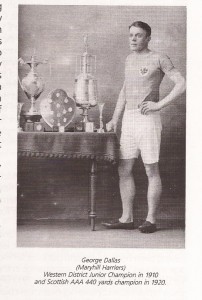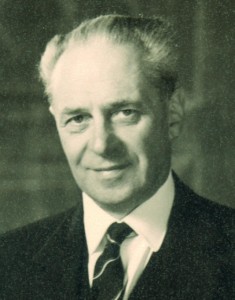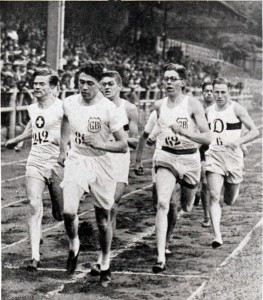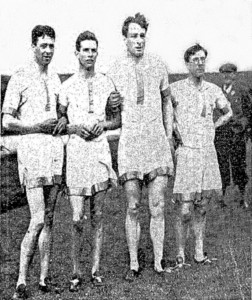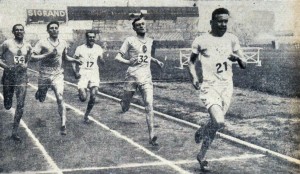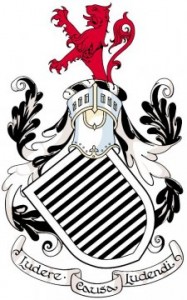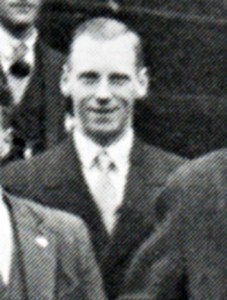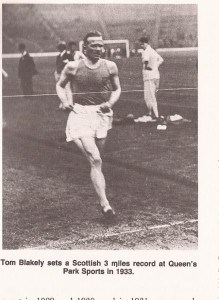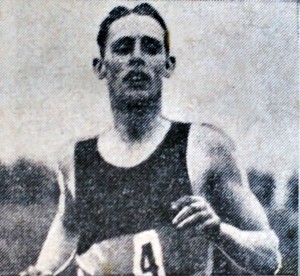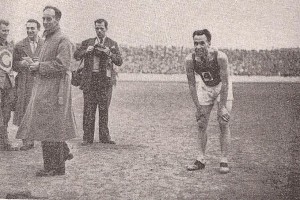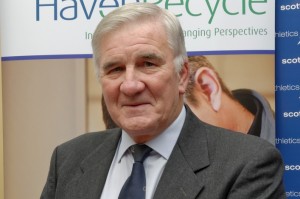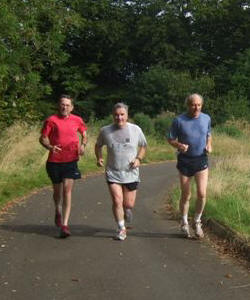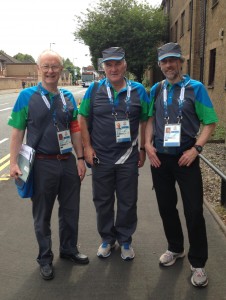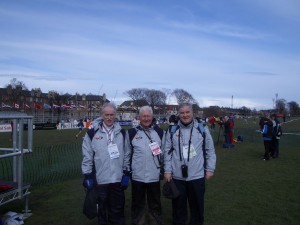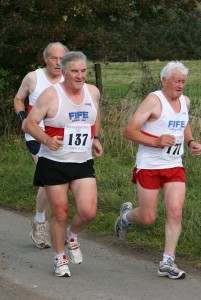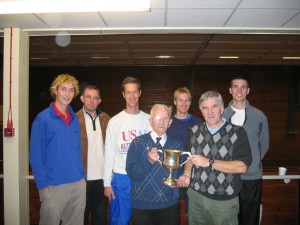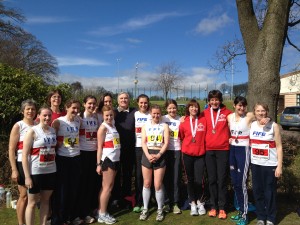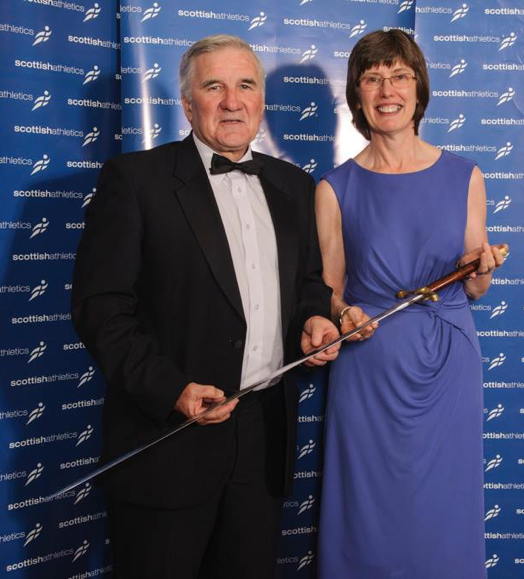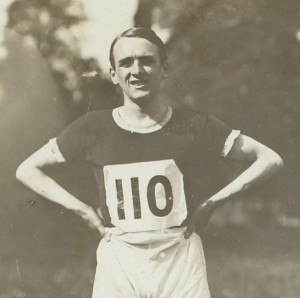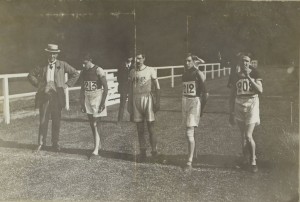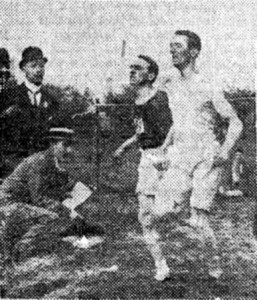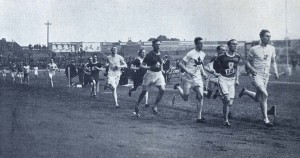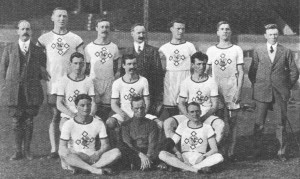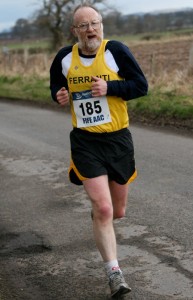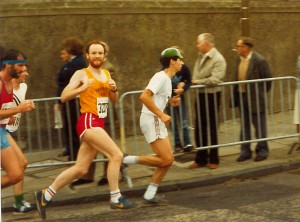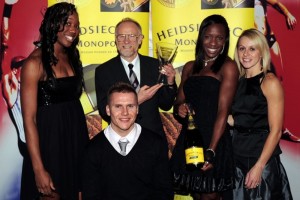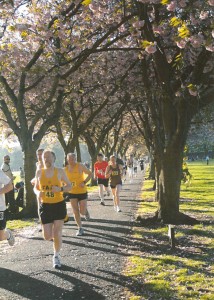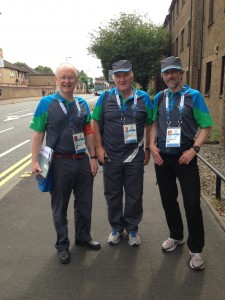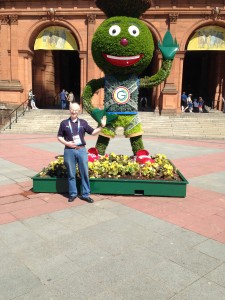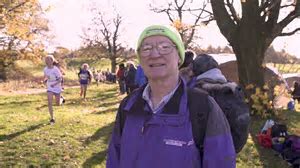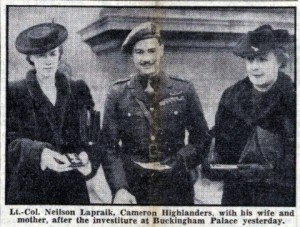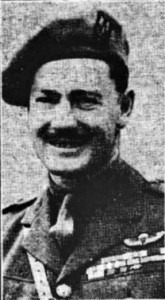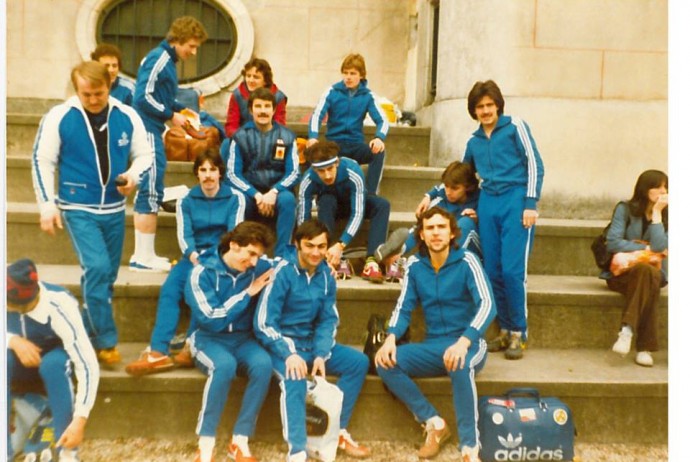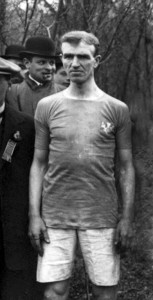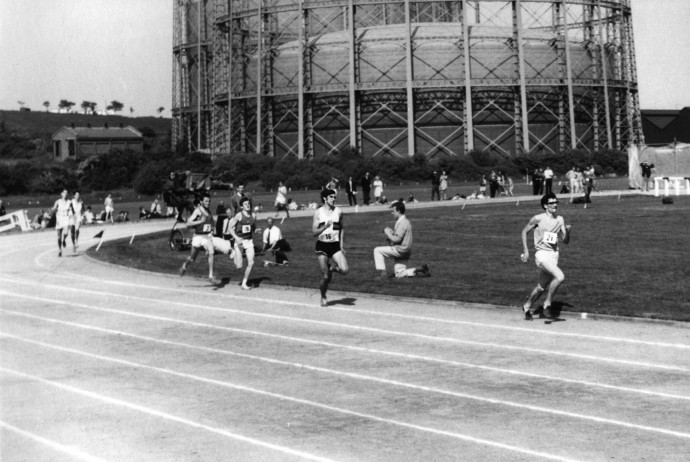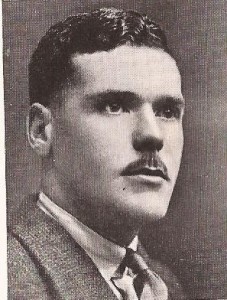 Tom Riddell: one of the stars of the QPFC Sports in the 20’s
Tom Riddell: one of the stars of the QPFC Sports in the 20’s
A WELCOME RESUMPTION
“Queen’s Park, probably the outstanding organisation in amateur sport in the countryresumed the function of sports promoters on Saturday after a lapse of nine years. This fact had aroused the keenest anticipation as to the quality of the fare, and possibly the high expectation accounted for the sense disappointment at the end of the proceedings. The various events failed in intensity, and as a whole, competition did not get beyond the commonplace. The heavy rain which fell midway through the meeting was no doubt influential in some degree in dulling the edge of interest, but when due allowance is made for this factor, there remains the impression of the need to discover some other cause which operated against the realisation of the expected standards. An examination of the programme discovered a great proportion of newcomers, concerning whom recent and reliable data for the estimation of capacity cannot have been available. To this may be attributed the lack of closeness in the majority of finishes. There were one or two notable exceptions, but on the whole the general remark made above is justified. Of course, as the season advances, data will accumulate, and the handicapper’s presently difficult task will be rendered less difficult.
The most interesting evet of the day was the senior relay race, and distinction was given to this by the presence of teams from Edinburgh and Glasgow Universities. Neither succeeded in outpacing the Maryhill Harriers combination, who owed much to George Dallas and to their slickness in exchanging the silken token. Glasgow University lost considerable ground rgeough the failure of Browning, who had run a fine furlong, to connect expeditiously with his colleague, and despite a magnificent quarter by Ball, the Edinburgh representative maintained himself in second place. If Glasgow can but develop a fair measure of intrepidity in exchanging, they will give the best of teams a hard run for victory.”
The above report appeared in the Glasgow Herald of June 9th, 1919 in the column ‘Notes on Sport’ welcoming the return of the event after the War. The actual report on the return of the Queen’s Park amateur sports, which appeared further through the paper, was shorter and told us that there were 7000 spectators. Events were 100 yards, 220 yards, half mile, Mile, Mile Invitation Relay, a schools relay race and a high jump – plus the almost obligatory five-a-=side which was won by Rangers (3 corners) from QPFC (2 corners). The sports were back. And Scotytish athletics were the better for it.
The Twenties started with two good meetings: good interms of total entries and close competition, good in terms of crowd turnout. but very few big names. The Sports of 1920 took place on 5th June with almost 12,000 spectators and in fine weather. Shettleston Harriers and Dumbarton FC had put on a counter-attraction in a meeting in Dumbarton and initially it was felt that this would affect entries and gate at Hampden while the Dumbarton event managed to attract only about 3000 paying customers. Despite that, the QPFC Sports were a great success. Several top names – eg Duncan McPhee – had admittedly headed off to the county event but competition was good in Glasgow. The name that jumps out to the modern student of athletics is that of George Dallas (Maryhill Harriers) who won the 440 yards off a mark of 5 yards in 50.8 seconds, and then ran the half-mile opening stage of the Mile Medley Relay for the winning Maryhill Harriers team. The report said that in fine weather, fully 12,000 spectators attended the event. It read:
“The meeting turned out to be quite successful, regarded from a sporting standpoint, while in respect of public attendance it was the best that the club has ever had, the crowd numbering not far short of 12,000. In the 100 yards handicap a considerable proportion of the competitors were long mark men with unfaniliar names, and in the final no back-marker found a place. The Scottish champion, AH Goodwin, was absent owing to illness, and interest was largely centred on JB Bell who, from 2 yards, won his heat in easy fashion, and also got home first in the semi-final; but the final was won in faster time than he has shown, the winner doing 10 2-5th seconds from 7 yards. In the heats of the furlong, Bell was unable to touch 23 seconds for the full distance, and in the 440 yards he did not finish.
Both the half-mile and the mile fell to Jas McFarlane of Maryhill Harriers from 25 and 35 yards respectively. The invitation relay race was deprived of some interest by the absence of the teams representing Glasgow and Edinburgh Universities, only Maryhill, West of Scotland and Edinburgh Northern Harriers taking part. The champions were easy winners, but it is quite possible that another result would have been seen if Glasgow Universityt had been able to raise a team, as in that case, JB Bell would have run against the winners rather than for them.
WL Hunter, Edinburgh University, competed in the high and broad jumps and the hurdles. He was unable to concede ths starts given in the jumps, but he won the hurdle race with a fine sustained effort. Giving AG Deans 16 yards, he made ground steadily, and the pair cleared the last hurdle simultaneously, the ex-champion obtaining the verdict at the tape.
A five-a-side football tournament was included in the programme, the first six First League clubs in the city being represented, and a win for Queen’s Park in the final tie formed an appropriate termination to a n enjoyable meeting.”
The 1921 meeting on 4th June was invaded by a big Edinburgh contingent including Eric Liddell and a two miles team from Edinburgh Southern Harriers that took first, second and third individual places in the event. Again we look at the Glasgpow Herald report as it was always the most complete of the dailies as far as Glagsow clubs were concerned. It said
“Queen’s Park Football Club were fortunate in the weather on Saturday, when they brought off their annual sports in conditions that were ideal alike for competitors and spectators, though probably the participantss in the five-a-side football tournament would have been suited with a lower temperature. The fine day and an unually attractive programme combined to swell the attendance which, estimated at something over 10,000, was by far the largest seen at an athletic meeting this season. As at several previous gatherings, fields were very large, the half-mile requiring four heats, while in the 100 yards the 160 competitors were divided into 20 heats. In addition to all the standard flat races, hurdles and jumps, the club staged several interesting novelties, among which was a relay race taken part in by teams representing Glasgow and Edinburgh respectively. The Edinburgh team, with the exception of EH Liddell, who won the first furlong, were somewhat disappointing in this event, but compensation was obtained in the two miles Harriers race, which was won by Edinburgh Southern Harriers, the club providing the first, second and third men home. Keen competition was also seen in the two invitation 100 yards and quarter mile races, and the only event that failed to meet anticipations was the hurdle handicap which lost much of its attractiveness with the absence of LJ Dunn. Perhaps the best individual performance of the afternoon was that of JCS Ponsford in the half-mile. With an allowance of 30 yards, he won his heat in 1 min 58 2-5th sec which equals the Scottish native record for the full distance, and in the final he returned nearly 2 seconds less. Ponsford ran with distinction in the Glasgow University sports last year, and if he chooses to compete in the championships nearer the end of the month he will be a force to be reckoned with in the half-mile.”
It only remains to add that Celtic won the five-a-side, defeating Queen’s Park by two goals to nil.
*
But 1922 was a different story. “A Meeting Of Champions” was the heading on the report on the sports of 1922 which began:
Probably the sports of the Queens Park Football Club will rank as the finest meeting of the season, not even excepting the Scottish Championships gathering in Edinburgh. Entries were large and included the champions at all distances, at the jumps and at the hurdles. It is true that they did not all compete in all the events for which they were entered, some reserving themselves for particular contests, such as the relay race, Edinburgh to Glasgow, but everyone made at least one appearance so that the proceedings were invested with an unusual interest from start to finish. Some disappointment was caused by the non-success of EH Liddell, the sprint champion, who failed to reproduce his usual form, but it is understood that he was suffering from a slight indisposition during the running of the open 100 yards handicap and the invitation sprint, and was unable to do himself justice.
Liddell won his heat and ran second in the semi-final of the open, but he was appreciably slower in the final, in which he was fourth. He ran better in the inter-city race, which would have been again won for Edinburgh but for the final half-mile of D McPhee, the champion at the distance. On starting McPhee was 15 yards behind CB Mein; at the finish he was two yards in front, the Edinburgh harrier being harassed by the strong adverse wind in the straight.”
Of the names mentioned, Liddell and McPhee are still well-known but CB Mein was a winner of medals of every colour at the SAAA Championships through the 1920’s and very good 880 yards specialist. Also running in the meeting was George Dallas who this year ran a 220 yards stage for the winning Glasgow team in the relay. Unfortunately this time the crowd was not nearly as good, being estimated at about 4000, due at least in part to poor weather at the start of the day discouraging the potential spectators from venturing out.
*
In 1923 it all came together – brilliant sunshine, six national champions and a crowd of 12,000. ” …. The six Scottish champions who took part were accompanied by most of the prominent athletes in the east and the west , but possibly the most pleasing feature of all was the presence in the field of runners who have hitherto shown little interest in participation in open meetings. Two of those newcomers distinguished themselves on Saturday. R McLean, the Glasgow High rugby footballer, running off the five and a half yards mark in the open hundred and nine yards in the furlong, captured both events in such excellent style as to suggest that were he to take to the track seriously he would prove a strong opponent for those in the first flight. His success was no surprise to those who have watched his running this season in inter-club relay races, and it would be interesting to see him opposed to Liddell and McColl over the quarter mile. The other newcomer who impressed was CD McTaggart, of Watson’s College, who established a new school record for the mile a month ago. Although he was competing in a field, the dimensions of which must have been disconcerting to his experience, his performance in running into fourth place, 15 yards behind J Dickson, the winner, whose time was 4 min 25 4-5th sec, was a creditable one.
It is questionable if JG McColl, the Glasgow University representative, has ever done better in an open meeting. In addition to his win in the invitation sprint, he secured second place in the open hundred and ran a very fine quarter in the relay race. In the invitation he ran very strongly and stalled off Liddell’s finishing burst by inches, and in addition to beating the champion, he had revenge on AF Clarke for his recent defeat in the University championships. The inter-city relay race was again won by Glasgow for the third consecutive time despite Liddell’s excellent effort in the second furlong to turn the tide of victory for Edinburgh, and it is evident that so long as Glasgow can call on the services of Duncan McPhee they are always likely to win this event. It was intended to include LJ Dunne in the Edinburgh side but the hurdles champion is nursing a leg injury at the present and stood down. He was present, however, and ran in the hurdles, but could only finish third to AF Clarke, to whom he was conceding six yards. Twelve teams turned out in the harriers team race, and here the contest between JG McIntyre and WGS Moore, of Edinburgh University, for first place was very keen for a major portion of the journey. In the dash at the finish, however, the Edinburgh man could not live with the champion, who won by 50 yards. Shettleston’s margin over Maryhill was a narrow one and, but for the pluck of A Barrie, who completed the last half-mile with only one shoe, they would not have won at all.”
Despite fine weather, a ‘good attendance’ and Olympic trials at 100, 400 and 800 metres, the Sports on 7th June 1924 were said to be a disappointment. How so? “With the Scottish championships due on Saturday next, it cannot be claimed that the Olympic trials over the 100, 400 and 800 metres which were introduced by Queen’s Park Football Club into the programme for their annual sports meeting at Hampden Park, served any useful purpose. In the absence of such prominent runners as EH Liddell, WR Milligan, EB Mein, AR Valentine and Duncan McPhee, they shed no new light on the problems faced by the selectors. It can however be said that both the 100 and 800 metres provided excellent finishes. In the sprint, AF Clarke snatched the victory from R McLean by a matter of inches, with J Crawford of Queen’s Park, just at the old High School boy’s shoulder. The finish in the distance event was equally close, half a yard separating WH Calderwood, JD Hope and JR McIntyre, the trio finishing in the order named. The 400 running event was almost a fiasco, only two of the ten runners invited turning out, and D McRae of Maryhill Harriers created a surprise by defeating his team mate AH Graham by three yards.
Apart from the disappointments of the trials, the meeting was up to the usual high standard associated with Queen’s Park gatherings. The visitors from Edinburgh captured a fair share of the prizes as, in addition to Clarke’s success in the 100 metres, they secured first places in the open 100, the hurdles, the harriers team race and the inter-city relay. The hurdles final with Clarke, LJ Dunn and JFA Wood competing was an exceptionally interesting race. Dunn, who has remodelled his style of hurdling since last season, had again to concede the honours to the champion who, in returning 12 2-th sec must have been in almost his best form. Dunn was unfortunate in the jump in which he covered 21′ 2″ as he came up against A Morrison of Glasgow University who, with a concession of 18″, touched 22′ 3.25″. The winner’s jump shows a very marked advance on his attempts at the University meetings. WF Weekes of Edinburgh Northern Harriers, and A Caponis of Glasgow University, ran a very close race in the open 100, and the Greek Student, as in the Celtic race of last August, was only robbed of first place by the narrowest of margins. In the two miles harrier team race, one of the keenest events of the day, JG McIntyre, the four and ten miles champion, finished first with G Malcolm occupying second, WD Patterson third and R Paterson seventh place, the team prize was easily taken by Edinburgh Southern Harriers. Edinburgh’s victory in the inter-city relay race was largely due to the excellent running of RS Mein in the quarter, where he transformed a leeway into an advantage which gave his brother an easy win in the concluding half mile.”
The final comments on the mile medley relay are interesting because they indicate the running order of (2 x 220) + (1 x 440) + (1 x 880). Most reports of the mile medley comment on the result of the ‘opening half mile’ and there are some others that list the order as (1 x 440) + (2 x 220) + (1 x 880). The race eventually settled to running the half mile first, then the two furlongs and finally the quarter mile whereas south of the Border the running order was usually the other way round with the quarter first and the half last.
With no Olympics in 1925, the meeting stood on its own two feet and was a magnificent success: all the top talent was there – CB Mein, Eric Liddell, WH Calderwood, Dunky Wright, Tom Riddell, Donald McLean, JG McIntyre, AF Clarke – with a crowd of 10,000 and good weather as well.
A BRILLIANT SUCCESS
The Queen’s Park Football Club’s annual meeting at Hampden Park on Saturday will rank as one of the most successful run by the club. For the first time this season we had brilliant sunshine and an absence of wind, the ideal conditions that make for good performances, and as a result the times recorded in the various events were much in front of anything we have had so far. The chief attraction for the 10,000 supporters lay in the presence of EH Liddell, and although the champion did not win the special quarter mile, he ran well enough, both in this event and also in the relay race, to suggest that he is approaching his true form. He was unofficially clocked as recording 50 1-5th sec in the quarter mile, and as he slowed down a little on approaching the tape, he may be taken as travelling a yard or two faster than that time. He appeared to be moving very much more freely in the quarter of the relay race, and defeated McCrae, the half mile champion, very easily over the distance. RA Robb, of Glasgow University, and JD Hope, the West of Scotland harrier, fought a very keen race for first place in the special quarter, and it was only in the last few strides that Robb got up to winin the excellent time of 49 4-5th sec.
New Scottish Record
The effect of Liddell’s running for the Edinburgh team in the relay race was reflected in the time returned, 3 min 39 4-5th sec – this being 1-5th better than the previous best over the distance, recorded by the Edinburgh University quartette in 1922. Glasgow’s chance was hopeless here from the completion of the first section, as CB Mein defeated RB McIntyre by three yards and FB Wardlaw and AF Clarke gave so little away in the two furlongs that McCrae, Glasgow’s fourth man, was asked to concede a yard to Liddell when the final quarter was entered upon. McIntyre’s failure was unexpected in view of his recent good form, but he had run previously in the invitation half which he won in comparatively slow time, and apparently this effort had taken too much out of him. At least Mein had no difficulty in shaking off his challenge when the pair settled down to race. The five who turned out in the special half mile included McCrae but he is evidently not quite fit, as he eased up in the finishing straight. The open half mile was won by JG Sloss of West Kilbride, off 80 yards, and the time, 1 min 56 sec, indicates that he has made great progress. Possessing a good style, he should go further. Off the 106 mark, J Dickson, Glasgow Harriers, captured the mile.
A Thrilling Duel
From the spectacular point of view, the tit-bit of the meeting was the finish of the two miles for harrier teams. Not since Johnston and McIntyre fought out their memorable duel in the championship last year has there been so thrilling a struggle as that which took place between T Riddell of Shettleston and D McLean, the Greenock policeman, who runs with Maryhill Harriers. The resemblance between the two races was further accentuated by the fact that Riddell, the winner, collapsed, like Johnston, after passing the tape. There was nothing between the pair from the moment the bell sounded until the finishing post was reached, and as an exhibition of splendid courage on the part of both runners, it could hardly be surpassed. Eastern runners generally do well at this meeting, and Gordon Thomson of Edinburgh Harriers carried on the tradition by winning both sprints. The finalists in the 100 yards covered the distance twice, owing to the four failing to notice the starter’s recall, and there was an exceptional incident in the youths’ race, where W Taylor of Hamilton Academy, after finishing first in the final, was disqualified for, it is said, some irregularity in his entry form.”
That’s the report and it seems to have been a very good meeting. The result of the two miles race referred was as follows:
1. T Riddell (Shettleston); 2. D McLean (Maryhill); 3. WH Calderwood (Maryhill); 4. R Paterson (Edinburgh Harriers); 5. D Wright (Shettleston); 6. F Stevenson (Monkland). Winning time: 9 min 42 sec. “Won at tape after desperate finish.”
The team race was won by Shettleston (1, 5, 12) 18 pts: 2. Edinburgh Southern Harriers (4, 7, 11) 22 pts.
*
